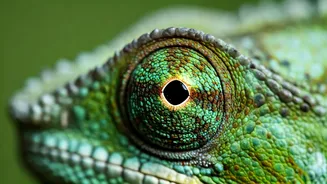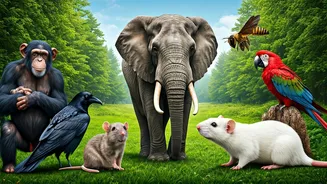The Majestic Tiger
The tiger's eyes are a stunning combination of amber, gold, or green, framed by a striking black outline. These striking eyes are not only beautiful but
also aid the tiger in hunting. Their forward-facing position, typical of predators, provides excellent depth perception, crucial for judging distances during a chase. The structure of their eyes allows them to see well in both bright sunlight and dim conditions, perfect for their crepuscular and nocturnal hunting habits. The slit-like pupils help regulate the amount of light entering the eyes, minimizing glare and enhancing their ability to see in low-light environments. The tiger's powerful gaze, combined with its sharp vision, makes it a formidable predator in the wild. Moreover, the tiger's eyes can convey different moods, from focused concentration during a hunt to gentle playfulness with cubs. These eyes also communicate social cues within the tiger's family structure.
The Wise Owl's Gaze
Owls have large, forward-facing eyes that are uniquely adapted for their nocturnal lifestyle. Their eyes are exceptionally large compared to the size of their head, providing a wide field of view. The structure of their eyes includes a high concentration of rod cells, which are sensitive to low light levels, enabling them to see even in the darkest environments. Owls also have a tapetum lucidum, a reflective layer behind the retina, which further enhances their night vision by reflecting light back through the retina for a second pass. Their eyes are fixed in their sockets, so owls cannot move their eyes, but they compensate by being able to rotate their heads up to 270 degrees. This unique ability provides them with an expansive view of their surroundings, essential for spotting prey and avoiding predators. The owl's intense gaze can project an air of wisdom and mystery, reflecting their hunting prowess and survival in challenging environments.
The Curious Chimpanzee
Chimpanzees possess eyes that closely resemble those of humans, allowing them to make strong eye contact and communicate complex emotions. The color of the chimpanzee's irises varies from brown to dark brown, surrounded by the whites of the eyes, which provide an added visual cue of their focus and intentions. Their eyes, like ours, are forward-facing, offering excellent depth perception. This feature is especially important for arboreal life, helping them judge distances while swinging through trees or interacting with their social group. Chimpanzees can display a range of emotions through their eyes, including joy, curiosity, sadness, and anger. These primates are highly social, and their expressive eyes play a key role in their intricate social dynamics, facilitating communication and understanding within their communities. Their ability to connect visually is a critical aspect of their intelligence and social complexity.
The Elegant Horse
Horses have large, laterally positioned eyes, providing them with a nearly 360-degree field of view. This extensive peripheral vision allows them to detect predators and monitor their environment with minimal head movement. The eyes of a horse vary in color, often being brown, but they can also be blue, hazel, or other shades. The unique structure of the horse's eye includes an oval-shaped pupil, which further enhances their vision by reducing glare and adjusting to different light conditions. Horses have a 'ramp' in their retina that acts like a 'line of sight', allowing them to see both near and far objects simultaneously. This feature is very helpful for grazing and spotting threats. Their eyes not only help them survive but also serve to display their inner state. A relaxed horse will have soft, gentle eyes, while a frightened horse will show wide, alert eyes.
The Playful Dolphin
Dolphins possess eyes with unique adaptations for underwater vision, making them perfect for their marine environment. Dolphin eyes are positioned on the sides of their heads, allowing for a wide field of view, helpful for spotting prey and avoiding predators. They have a lens and cornea that are adapted to compensate for light refraction in water. This feature allows them to see clearly both above and below the surface. Dolphins also have a tapetum lucidum, improving their night vision. Their eye color varies, including shades of gray, brown, and blue, often reflecting the color of their marine habitat. Dolphins' eyes are crucial for their complex social behaviors and communication. Their expressive eyes enable them to show a range of emotions, including playfulness, curiosity, and affection, strengthening their bonds within their pods.
The Graceful Leopard
The leopard’s eyes are captivating, adding to its mystique and stealth. Their eyes are typically golden or green, set against a backdrop of rich fur patterns. Like tigers, their forward-facing eyes enable superior depth perception, crucial for hunting. Leopards have a tapetum lucidum, which dramatically enhances their night vision, permitting them to hunt in low-light conditions. Their pupils are round, contracting to slits in bright light, aiding in glare reduction. The leopard's gaze speaks of patience and power, essential for both survival and hunting. Their eyes convey a sense of vigilance, highlighting their adaptability and prowess as apex predators. The intense focus shown in their eyes shows their deep connection to their environment, which enables them to survive across many different habitats.
The Alert Fox
Foxes have eyes that often appear amber or golden, lending them a cunning and watchful appearance. Their eyes are positioned forward, enabling stereoscopic vision, critical for precise depth perception during hunts. Foxes have a tapetum lucidum, which enhances their night vision, permitting them to hunt effectively at dusk and dawn. They have vertical slit pupils, allowing them to control the amount of light entering their eyes, improving their vision in a variety of conditions. The fox's eyes reflect an alert and intelligent nature, conveying their natural ability to adapt to their environments. The shape and color of their eyes contribute to their unique ability to blend into different landscapes, while their keen vision highlights their success as both hunters and survivors in the wild.




